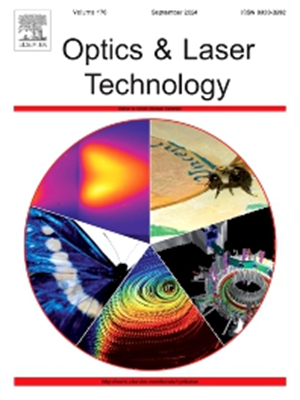fpga实现的实时DSP框架使实验50 m光子学辅助毫米波链路具有增强的频率偏移补偿
IF 5
2区 物理与天体物理
Q1 OPTICS
引用次数: 0
摘要
实验展示了一个50 m无线w波段光子辅助传输系统,该系统采用fpga实现实时DSP,实现了7.3728 GBaud的正交相移键控(QPSK)信号的鲁棒恢复。数字信号处理(DSP)框架的核心是一种新的频偏估计算法,称为PF-CT-FOE,该算法将相位折叠与累积相变反馈相结合,解决了实时光子辅助毫米波系统中大频偏补偿的精度和效率权衡。基于这一创新,建立了一个专门针对光子辅助毫米波传输优化的并行实时DSP框架。通过全面的数值模拟,我们对T/2间隔恒模算法(T/2 CMA)和所提出的FOE算法的性能进行了表征,同时在现场可编程门阵列(FPGA)平台上全面实现和验证了所有信号均衡和恢复组件。该系统在128并行FPGA路径上实现,在100 m光纤和50 m无线链路上实现7.3728 GBaud QPSK信号的实时恢复,其误码率为1.2 × 10-4,低于HD-FEC的3.8 × 10-3阈值。这项工作为需要亚毫秒延迟的成本敏感毫米波回程部署建立了一条实用的途径。本文章由计算机程序翻译,如有差异,请以英文原文为准。
Fpga-implemented Real-Time DSP framework enabling experimental 50 m Photonics-Aided Millimeter-Wave links with enhanced frequency offset compensation
We experimentally demonstrate a 50 m wireless W-band photonics-aided transmission system with FPGA-implemented real-time DSP, achieving robust 7.3728 GBaud quadrature phase shift keying (QPSK) signal recovery. At the core of the digital signal processing (DSP) framework lies a novel frequency offset estimation algorithm, termed PF-CT-FOE, that integrates phase folding with cumulative phase transition feedback, resolving the accuracy-efficiency trade-off in large-frequency-offset compensation for real-time photonics-aided millimeter-wave systems. Building on this innovation, a parallelized real-time DSP framework is established specifically optimized for photonics-aided millimeter wave transmission. Through comprehensive numerical simulations, we characterized the performance of both the T/2-spaced constant modulus algorithm (T/2 CMA) and the proposed FOE algorithm, while all signal equalization and recovery components were fully implemented and validated on a field-programmable gate array (FPGA) platform. Implemented on 128-parallel FPGA paths, the system achieves real-time recovery of 7.3728 GBaud QPSK signals over 100 m fiber and 50 m wireless links with 1.2 × 10-4 BER, below the 3.8 × 10-3 threshold for HD-FEC. This work establishes a practical pathway for cost-sensitive millimeter-wave backhaul deployments requiring sub-ms latency.
求助全文
通过发布文献求助,成功后即可免费获取论文全文。
去求助
来源期刊
CiteScore
8.50
自引率
10.00%
发文量
1060
审稿时长
3.4 months
期刊介绍:
Optics & Laser Technology aims to provide a vehicle for the publication of a broad range of high quality research and review papers in those fields of scientific and engineering research appertaining to the development and application of the technology of optics and lasers. Papers describing original work in these areas are submitted to rigorous refereeing prior to acceptance for publication.
The scope of Optics & Laser Technology encompasses, but is not restricted to, the following areas:
•development in all types of lasers
•developments in optoelectronic devices and photonics
•developments in new photonics and optical concepts
•developments in conventional optics, optical instruments and components
•techniques of optical metrology, including interferometry and optical fibre sensors
•LIDAR and other non-contact optical measurement techniques, including optical methods in heat and fluid flow
•applications of lasers to materials processing, optical NDT display (including holography) and optical communication
•research and development in the field of laser safety including studies of hazards resulting from the applications of lasers (laser safety, hazards of laser fume)
•developments in optical computing and optical information processing
•developments in new optical materials
•developments in new optical characterization methods and techniques
•developments in quantum optics
•developments in light assisted micro and nanofabrication methods and techniques
•developments in nanophotonics and biophotonics
•developments in imaging processing and systems

 求助内容:
求助内容: 应助结果提醒方式:
应助结果提醒方式:


